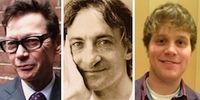In an inventive book that pictures U.S. cities as aristocrats, explorers and Native Americans, Raschka (Mysterious Thelonius
) blithely explains that "a thousand names, a hundred languages... and a million people name one nation." New York, in its post–Nieuw Amsterdam incarnation, appears as a bewigged and snow-white-powdered Duke of York, prancing in a red coat and buckle shoes. Like the other personified cities, he wears a hat that alludes to his home's distinctive architecture—in this case, a stylized sky-blue Empire State Building. Multiethnic New Yorkers might rightly protest this monochromatic and dandyish depiction. But optimistic Raschka barely alludes to the conflicts and mixed populations that give places their names. Graceful Minneapolis, "part Sioux, part Greek," does stand a bit aloof, but overall these variegated cities get along. New York throws a party and invites German princess Charlotte, dancing Waikiki, San Francisco cloaked in brown monk's robes (for its St. Francis of Assisi roots) and Pittsburgh, who wears a Revolutionary general's blue coat and a cap topped with three steel-era smokestacks. Conversation starts slowly, but then "Beulah met Bethesda. They're both Aramaic!" and Greek, white-bearded Philadelphia clasps hands with Memphis, called after an Egyptian city. At the end of the night, New York politely says, "Buenos noches, Las Vegas. Au revoir, Lafayette. Darling Salem, shalom." Raschka's lilting approximate rhyme, and his piquant watercolors on clean white paper, make this book an aural and visual pleasure, a gateway to understanding the complicated histories in unusual words' origins. Ages 4-7. (Oct.)



